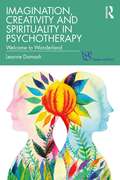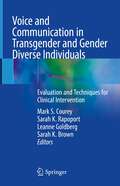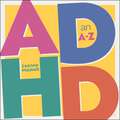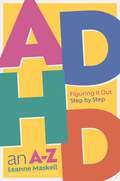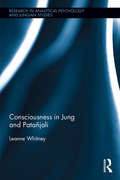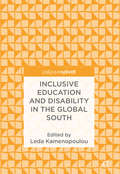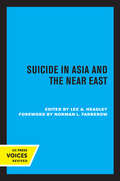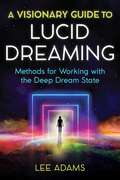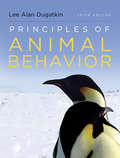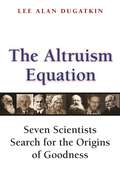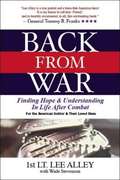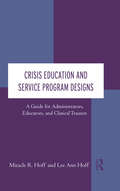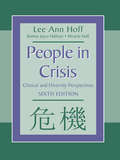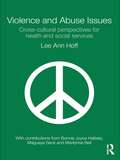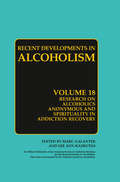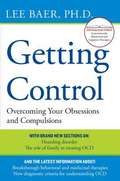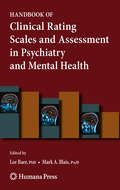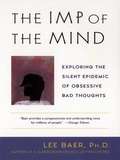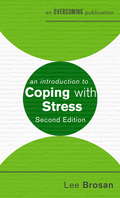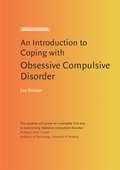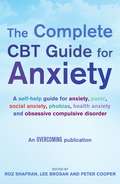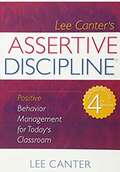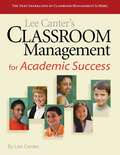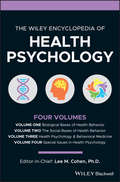- Table View
- List View
Imagination, Creativity and Spirituality in Psychotherapy: Welcome to Wonderland (Psyche and Soul)
by Leanne DomashThe aim of this book is to awaken creative desire and expand the imagination of the psychotherapist and, in turn, her patient. Each chapter is meant to surprise the reader and help him see the world in a new way. Many varieties of imagination are explored -- the spiritual, the relational, the dreamworld, the aesthetic and the adaptive. The author offers space to reflect, to daydream, to remember; space to pursue goals, to make new connections; space to take risks and space to be wrong. The psychotherapist is encouraged to find her own voice, be poetic, dare to create, converse with other disciplines and, most especially, enter the world of dreams. This is all passed onto the patient as the dyad enters the intersubjective field. Both scholarly and practical, this volume elegantly and persuasively synthesizes for the first time research in many fields, including spirituality and Kabbalah, neuroscience, the arts, biology and artificial intelligence, to give an in depth and original understanding of the current pressing problems in the rapidly changing field of psychotherapy: how do we work with unconscious processes and early memories to help our patients become more imaginative, creative, hopeful and resilient, and in so doing, heal. The relationship between the body and creative imagination is fully explored as well as the disruptive effect of trauma on the imagination and how to address this. The emphasis on surprise, uncanny communication, interdisciplinary inquiry, use of dreamwork and the imagination of the body — how it spontaneously meets new challenges— all stimulate the creativity of the reader. Through numerous case studies, the author illustrates the practical implications of how this exploration allows for deeper understanding and more effective treatment. With the innovative synthesis and specific techniques the author provides, the clinician has tools to carry on the work of moving the field of psychotherapy forward as well as work ever more effectively with patients.
Voice and Communication in Transgender and Gender Diverse Individuals: Evaluation and Techniques for Clinical Intervention
by Mark S. Courey Sarah K. Rapoport Leanne Goldberg Sarah K. BrownThis book serves as a guide to any patient, clinician, or person who desires to understand how transgender and gender diverse individuals can be assisted in achieving voice and communication congruity with gender. Voice and communication style serve as intricate links to one’s identity and are central aspects of the gender transition process. Guiding a transgender or gender diverse patient through this transition is complex, requiring an understanding of the patient’s desires, the ability to identify and work with patients to achieve sustainable patterns of behavioral modification that affect voice in a positive manner, and an understanding of the role of newly emerging surgical techniques. This is best addressed by an interdisciplinary team, and this book makes this material available in one source. The first section of the book consists of introductory chapters written by primary care physicians, endocrinologists, and psychiatrists addressing the complex nature of transition from the medical standpoint. A review of hormonal replacement therapies, psychological evaluations, and potential effects of hormone replacement on voice is included. The second section describes the behavioral techniques available in speech and voice therapy for voice change and addresses outcomes that can be expected from behavioral intervention. Each chapter addresses the physiologic principles of therapeutic techniques for effecting change, techniques of instruction, nuances for transgender and gender diverse patients, methods of generalization, and methods of maintenance. Finally, the third section of the book details the surgical techniques available to assist patients in voice transition and their expected outcomes for voice modification. Each chapter includes an introduction, preoperative assessment, role of preoperative therapy, surgical technique, postoperative management, and expected outcome. This section also includes a surgical atlas. This is an ideal guide for otolaryngologists, speech-language pathologists, primary care providers, as well as psychiatrists and endocrinologists caring for transgender and gender nonconforming patients.
ADHD an A-Z: Figuring it Out Step by Step
by Leanne MaskellA guide to navigating life as a young adult with ADHD - from someone who's been through it allNavigating the world with an ADHD brain can be exhausting. The rollercoaster ride from clinical assessments through diagnosis to treatment can leave you feeling anxious and isolated, worried about failing or feeling different.This handy guide is here to change all that. If you have (or suspect you have) ADHD, you'll know the frustration of being given neurotypical or clinical advice - but this is straight from an ADHD brain to you.The accessible A-Z format, covering everything from burnout and finances to time management and relationships, gives you the tips and confidence you need to reach your full potential. It empowers you to understand why ADHD brains work the way they do and how to harness your unique mind to think creatively and overcome any hurdle life throws at you.Easy to digest and full to the brim with practical life advice including budgeting plans for impulsive spending, advice on rejection sensitive dysphoria and ways to relax, this audiobook provides everything you need to feel confident and supported through your ADHD diagnosis and beyond.(P) 2022 Jessica Kingsley Publishers
ADHD an A-Z: Figuring it Out Step by Step
by Leanne MaskellNavigating the world with an ADHD brain can be exhausting. The rollercoaster ride from clinical assessments through diagnosis to treatment can leave you feeling anxious and isolated, worried about failing or feeling different.This handy guide is here to change all that. If you have (or suspect you have) ADHD, you'll know the frustration of being given neurotypical or clinical advice - but this is straight from an ADHD brain to you.The accessible A-Z format, covering everything from burnout and finances to time management and relationships, gives you the tips and confidence you need to reach your full potential. It empowers you to understand why ADHD brains work the way they do and how to harness your unique mind to think creatively and overcome any hurdle life throws at you.Easy to digest and full to the brim with practical life advice including budgeting plans for impulsive spending, advice on rejection sensitive dysphoria and ways to relax, this book provides everything you need to feel confident and supported through your ADHD diagnosis and beyond.
Consciousness in Jung and Patañjali (Research in Analytical Psychology and Jungian Studies)
by Leanne WhitneyThe East-West dialogue increasingly seeks to compare and clarify contrasting views on the nature of consciousness. For the Eastern liberatory models, where a nondual view of consciousness is primary, the challenge lies in articulating how consciousness and the manifold contents of consciousness are singular. Western empirical science, on the other hand, must provide a convincing account of how consciousness arises from matter. By placing the theories of Jung and Patañjali in dialogue with one another, Consciousness in Jung and Patañjali illuminates significant differences between dual and nondual psychological theory and teases apart the essential discernments that theoreticians must make between epistemic states and ontic beliefs. Patañjali’s Classical Yoga, one of the six orthodox Hindu philosophies, is a classic of Eastern and world thought. Patañjali teaches that notions of a separate egoic "I" are little more than forms of mistaken identity that we experience in our attempts to take ownership of consciousness. Carl Jung’s depth psychology, which remains deeply influential to psychologists, religious scholars, and artists alike, argues that ego-consciousness developed out of the unconscious over the course of evolution. By exploring the work of key theoreticians from both schools of thought, particularly those whose ideas are derived from an integration of theory and practice, Whitney explores the extent to which the seemingly irremediable split between Jung and Patañjali’s ontological beliefs can in fact be reconciled. This thorough and insightful work will be essential reading for academics, theoreticians, and postgraduate students in the fields of psychology, philosophy of science, and consciousness studies. It will also appeal to those interested in the East–West psychological and philosophical dialogue.
Inclusive Education and Disability in the Global South
by Leda KamenopoulouThis edited volume examines inclusive education and disability in the global South. Presenting four qualitative research studies conducted in Malaysia, Bhutan, Philippines and Belize, the authors examine the implementation of inclusive education and disabled children’s participation in the education system: contexts on which very little is known. Thus, this book provides a unique opportunity to access rare context-specific information concerning this region of the world; and to reflect on the particular challenges some countries face in the realization of full participation of all children within education. Authored by researchers who are also teaching professionals with experience and understanding of the complexities of the real world, this book reminds us that researchers and policy makers must listen to all voices and perspectives: especially those that have remained silenced and ignored.
Suicide in Asia and the Near East
by Lee A. HeadleyThis title is part of UC Press's Voices Revived program, which commemorates University of California Press’s mission to seek out and cultivate the brightest minds and give them voice, reach, and impact. Drawing on a backlist dating to 1893, Voices Revived makes high-quality, peer-reviewed scholarship accessible once again using print-on-demand technology. This title was originally published in 1983.
A Visionary Guide to Lucid Dreaming: Methods for Working with the Deep Dream State
by Lee Adams• Provides an extensive inventory of beginning, intermediate, and advanced tools and practices for meaningful lucid dreamwork and shows how dreams can shape our conscious reality if we incorporate them into waking life • Offers guidance to help you overcome mental or physical obstacles, including ways to stop sleep paralysis • Examines supplements to aid lucid dreaming practice and increase the vividness and recall of dreams Dreams offer a gateway into our psyche. Through lucid dreaming--when you have conscious awareness during sleep--you can access and interact with the subconscious mind for greater self-awareness, personal development, and transformation. In this step-by-step guide to dreamwork, Lee Adams provides tools and techniques for encouraging, remembering, and using lucid dreams for personal growth as well as how to have big dreams that leave a lasting impact. Beginning with an overview of the history of lucid dreaming, he shares tried-and-true foundational practices to get you started--practices for before sleep, during sleep, and after dreaming. Drawing upon Jungian depth psychology, recent research in neuroscience, and years of personal dream practice, Adams then offers an extensive inventory of intermediate and advanced methods to support meaningful dreamwork, such as the Wake Induced Lucid Dreams technique (WILD), where you fall asleep while conscious and transport your active awareness into a dream state. He also explores dream companions, symbols of the unconscious mind, dream interpretation, and working with the shadow side of the self. He examines how dreams can shape our conscious reality if we incorporate them or their symbols into waking life. He offers guidance to help you overcome any mental or physical obstacles you may encounter, including ways to stop sleep paralysis. He also examines supplements to aid lucid dreaming practice, improve dream recall, and increase the vividness of dreams, such as Alpha-GPC, 5-HTP, Silene undulata, Mugwort, the mushroom Lion&’s Mane, and Galantamine. With this practical guide, you can ignite your mind&’s capacity to wake up to your own dreams and restructure your world to be more attuned to your deeper self.
Principles of Animal Behavior
by Lee Alan DugatkinPrinciples of Animal Behavior has long been considered the most current and engaging introduction to animal behavior. The Third Edition is now also the most comprehensive and balanced in its approach to the theoretical framework behind how biologists study behavior.
The Altruism Equation: Seven Scientists Search for the Origins of Goodness
by Lee Alan DugatkinIn a world supposedly governed by ruthless survival of the fittest, why do we see acts of goodness in both animals and humans? This problem plagued Charles Darwin in the 1850s as he developed his theory of evolution through natural selection. Indeed, Darwin worried that the goodness he observed in nature could be the Achilles heel of his theory. Ever since then, scientists and other thinkers have engaged in a fierce debate about the origins of goodness that has dragged politics, philosophy, and religion into what remains a major question for evolutionary biology.The Altruism Equation traces the history of this debate from Darwin to the present through an extraordinary cast of characters-from the Russian prince Petr Kropotkin, who wanted to base society on altruism, to the brilliant biologist George Price, who fell into poverty and succumbed to suicide as he obsessed over the problem. In a final surprising turn, William Hamilton, the scientist who came up with the equation that reduced altruism to the cold language of natural selection, desperately hoped that his theory did not apply to humans.Hamilton's Rule, which states that relatives are worth helping in direct proportion to their blood relatedness, is as fundamental to evolutionary biology as Newton's laws of motion are to physics. But even today, decades after its formulation, Hamilton's Rule is still hotly debated among those who cannot accept that goodness can be explained by a simple mathematical formula. For the first time, Lee Alan Dugatkin brings to life the people, the issues, and the passions that have surrounded the altruism debate. Readers will be swept along by this fast-paced tale of history, biography, and scientific discovery.
Back from War: Finding Hope and Understanding in Life After Combat
by Lee Alley Wade Stevenson<p><i>Back From War: Finding Hope and Understanding in Life After Combat</i> is the harrowing narrative of 1st Lt. Lee Alley and his year in the horrors of combat in the Mekong Delta of Vietnam from 1967-1968 and his reflections on the years since. <p>Additionally, it is the true accounts of twelve other contributors, their time at war and stories of their return home. All of them discuss feelings of maladjustment, loneliness, depression, bouts of PTSD and negative family repercussions that are similarly felt by many of our nation's veterans of foreign wars. <p>Lee Alley made a life for himself, but never spoke of his war experiences. Thirty-two years later, he and his "brothers-in-arms" began to reconnect and have recently begun to heal some of their suffering by gathering at veteran reunions. Lee Alley's message is clear: America's soldiers are forever changed, but they are never alone. <p><i>Back From War</i> is dedicated to all veterans and their families as a guide for the readjustment to civilian life.</p>
Crisis Education and Service Program Designs: A Guide for Administrators, Educators, and Clinical Trainers
by Lee Ann Hoff Miracle R. HoffCrisis Education and Service Program Designs, is a guide for educators, administrators, and clinical trainers who may otherwise feel ill-prepared for the complex tasks of teaching, program development, supervision, and consultation in the crisis-care arena. The book provides a framework for more systematic inclusion of crisis content in health and human-service programs. Readers will find that this book fills the current gaps in knowledge and training, and fosters a more holistic practice by all human-service professionals. It shows how effective leadership, training, and timely support contribute to crisis workers’ effective practice with people in crisis.
People in Crisis: Clinical and Diversity Perspectives
by Lisa Brown Lee Ann Hoff Miracle R. HoffThe first edition of People in Crisis, published in 1978, established success as a comprehensive and user-friendly text for health and social service professionals. The book and its following incarnations included critical life events and life cycle transition challenges, clearly pointing out the interconnections between such events, stressful developmental changes, and their potential for growth but also danger of suicide and/or violence toward others. This revised edition includes new case examples and expanded coverage of cross-cultural content, including 'commonalities and differences' in origins, manifestations, and crisis responses. The authors illustrate the application of crisis concepts, assessment, and intervention strategies across a wide range of health and mental health settings, as well as at home, school, workplace, and in the community. Each chapter contains a closing summary that includes discussion questions, references, and online data sources for maximum application and learning. Updated chapters discuss new, research-based content on: • workplace violence and abuse• youth violence in schools and higher education settings• the use of psychotropic drugs, including for very young children in the absence of comprehensive assessment• the crisis vulnerability of war veterans and the hazards of 'pathologizing' what should be considered a 'normal' response to the repeated and catastrophic trauma of war• the intersection of socio-political factors with individuals’ psychological healing from catastrophic experiences such as war and natural disaster.
Violence and Abuse Issues: Cross-Cultural Perspectives for Health and Social Services
by Lee Ann HoffAfter centuries of being considered a private matter in most societies, violence and its profound effect on the physical health, mental health, and social well-being of victims and their families, as well as on the assailants themselves, has started to take centre stage as a public issue of worldwide concern. Health and social service providers are in pivotal positions to provide preventive and restorative services to those affected by violent and abusive behaviour. This comprehensive textbook presents theoretical background and practical strategies for doing so, providing a solid knowledge base for good practice in this area. It emphasizes the interdisciplinary aspects of violence and victim/survivor care and addresses violence over the lifespan, covering: child sexual and physical abuse sexual assault of adults battering and emotional abuse of intimate partners elder abuse perpetrators of violence and abuse violence in learning and work environments vicarious trauma and self-care interconnections between various forms of violence, including socially approved violence in the media and in war. This text is an essential resource for qualified practitioners wanting to learn more about this area and for students starting out in health and social care. Each chapter includes case studies and thinking points, and suggestions for application in practice settings. A companion website provides materials for students and educators, enabling the inclusion of violence issues in an already busy curriculum. Lee Ann Hoff is a nurse-anthropologist and crisis specialist. She has published widely and is the author of the award-winning textbook People in Crisis. She has extensive experience as an educator, consultant, clinician, and crisis service manager.
Research on Alcoholics Anonymous and Spirituality in Addiction Recovery
by Marc Galanter Lee Anne KaskutasIt was once taken for granted that peer-assisted groups such as Alcoholics Anonymous had no "real" value in recovery from addiction. More recently, evidence-based medicine is recognizing a spiritual component in healing--especially when it comes to addiction. The newest edition of Recent Developments in Alcoholism reflects this change by focusing on the 12-step model of recovery as well as mindfulness meditation and other spiritually oriented activity. More than thirty contributors bring together historical background, research findings, and clinical wisdom to analyze the compatibility of professional treatment and nonprofessional support, day-to-day concepts of relapse prevention, the value of community building in recovery, and much more. Among the topics covered: (1) How and why 12-step groups work. (2) The impact of the spiritual on mainstream treatment. (3) The impact of AA on other nonprofessional recovery programs. (4) AA outcomes for special populations. (5) Facilitating involvement in 12-step programs. (6) Methods for measuring religiousness and spirituality in alcohol research. Whether one is referring clients to 12-step programs or seeking to better understand the process, this is a unique resource for clinicians and social workers. Developmental psychologists, too, will find Volume 18--Research on Alcoholics Anonymous and Spirituality in Addiction Recovery a worthy successor to the series.
Getting Control
by Lee BaerThoroughly revised and updated--the go-to book for OCD sufferers who want to master their fears and take charge of their livesThe first comprehensive guide to treating obsessive compulsive disorder based on clinically proven behavioral therapy techniques, Dr. Lee Baer's Getting Control has been providing OCD sufferers with information and relief for more than twenty years. In the same easy-to-understand format as the original, this updated edition includes: * Cutting-edge behavioral therapy techniques * Breakthrough advances in neuroscience * Brand new material on hoarding * Expanded sections on how families can help OCD sufferers * The latest diagnostic standards as outlined by the American Psychiatric Association * A completely revised list of resources OCD sufferers and their loved ones will find everything they need to assess their symptoms, set realistic goals, and create specific therapeutic exercises for managing this disorder.
Handbook of Clinical Rating Scales and Assessment in Psychiatry and Mental Health
by Lee Baer Mark A. BlaisPsychiatric clinicians should use rating scales and questionnaires often, for they not only facilitate targeted diagnoses and treatment; they also facilitate links to empirical literature and systematize the entire process of management. Clinically oriented and highly practical, the Handbook of Clinical Rating Scales and Assessment in Psychiatry and Mental Health is an ideal tool for the busy psychiatrist, clinical psychologist, family physician, or social worker. In this ground-breaking text, leading researchers provide reviews of the most commonly used outcome and screening measures for the major psychiatric diagnoses and treatment scenarios. The full range of psychiatric disorders are covered in brief but thorough chapters, each of which provides a concise review of measurement issues related to the relevant condition, along with recommendations on which dimensions to measure - and when. The Handbook also includes ready-to-photocopy versions of the most popular, valid, and reliable scales and checklists, along with scoring keys and links to websites containing on-line versions. Moreover, the Handbook describes well known, structured, diagnostic interviews and the specialized training requirements for each. It also includes details of popular psychological tests (such as neuropsychological, personality, and projective tests), along with practical guidelines on when to request psychological testing, how to discuss the case with the assessment consultant and how to integrate information from the final testing report into treatment. Focused and immensely useful, the Handbook of Clinical Rating Scales and Assessment in Psychiatry and Mental Health is an invaluable resource for all clinicians who care for patients with psychiatric disorders.
The Imp of the Mind
by Lee BaerIn The Imp of the Mind, a leading expert on Obsessive Compulsive Disorder explores the hidden epidemic that afflicts millions of Americans. In the first book to fully examine obsessive bad thoughts, Dr. Lee Baer combines the latest research with his own extensive experience in treating this widespread syndrome. Drawing on information ranging from new advances in brain technology to pervasive social taboos, Dr. Baer explores the root causes of bad thoughts, why they can spiral out of control, and how to recognize the crucial difference between harmless and dangerous bad thoughts. An illuminating and accessible guide to the kinds of thoughts that create extreme fear, guilt, and worry, The Imp of the Mind provides concrete solutions to a tormenting and debilitating disorder. Including special sections on the prescription medications that have proven effective, it is "a beautifully written book that can be a great help to people who want to know what to do about obsessions" (Isaac Marks, M. D. , author of Living with Fear: Understanding and Coping with Anxiety). .
An Introduction to Coping with Stress (An Introduction To Coping Ser.)
by Lee BrosanA revised and updated edition in the popular 'Introduction to Coping with' series of self-help books. Written by the author of the popular self-help title Overcoming Stress, An Introduction to Coping with Stress 2nd Edition offers a first step in self-help, using techniques from cognitive behavioural therapy (CBT). We all know what stress feels like, and indeed what it feels like when we have too much stress in our lives. Too much stress can have a negative impact on us, almost without our noticing it. It can affect our family life, friendships and other relationships, our work life and our physical and emotional wellbeing. This self-help guide uses CBT strategies to help the reader to recognise what happens to us when we are under stress and how we can change how we feel, think and act in order to regain a more balanced outlook on life and manage it more effectively. This practical booklet is also an ideal resource for health professionals and carers.
Introduction to Coping with Obsessive Compulsive Disorder (Coping With Ser.)
by Lee BrosanObsessive compulsive disorder (OCD) affects millions of people each year. But it can be treated effectively with cognitive behavioural therapy (CBT). Written by an experienced practitioner, this introductory book explains what OCD is, what different forms it takes and how it can make you feel. It will help you to understand your symptoms and is ideal as an immediate coping strategy and as a preliminary to fuller therapy. You will learn:· How OCD develops and what keeps it going· The role that intrusive thoughts play in your compulsive behaviour· Cognitive skills and exposure and response prevention techniques
The Complete CBT Guide for Anxiety
by Roz Shafran Lee Brosan Prof Peter CooperOvercoming app now available.A highly respectable and authoritative self-help guide on all the anxiety disorders: generalised anxiety disorder, health anxiety, panic, phobias, social anxiety, OCD.Edited by three leading CBT clinicians in the UK, this comprehensive guide offers individual CBT-based treatments for a wide range of anxiety problems. Each individual treatment reflects current the treatment in the UK for that anxiety disorder and is written by the clinician responsible for developing that treatment in the first place.Contributors include:Lars-Goran Ost (phobias)Dr Gillian Butler (social phobia - Gillian is the author of Overcoming Social Anxiety & Shyness) Anke Ehlers & Jennifer Wild (PTSD)Nick Grey & David M. Clark (panic disorder)Heather Hadjistavropoulos (health anxiety)Kevin Meares & Mark Freeston (Generalised Anxiety Disorder) Roz Shafran & Adam Radomsky (OCD)An ideal resource not only for those experiencing anxiety problems, but CBT therapists and IAPT workers.
The Complete CBT Guide for Anxiety: A Self-help Guide For Anxiety, Panic, Social Anxiety, Phoblas, Health Anxiety And Obsessive Compulsive Disorder
by Roz Shafran Lee Brosan Peter CooperOvercoming app now available via iTunes and the Google Play Store.A highly respectable and authoritative self-help guide on all the anxiety disorders: generalised anxiety disorder, health anxiety, panic, phobias, social anxiety, OCD.Edited by three leading CBT clinicians in the UK, this comprehensive guide offers individual CBT-based treatments for a wide range of anxiety problems. Each individual treatment reflects current the treatment in the UK for that anxiety disorder and is written by the clinician responsible for developing that treatment in the first place.Contributors include:Lars-Goran Ost (phobias)Dr Gillian Butler (social phobia - Gillian is the author of Overcoming Social Anxiety & Shyness) Anke Ehlers & Jennifer Wild (PTSD)Nick Grey & David M. Clark (panic disorder)Heather Hadjistavropoulos (health anxiety)Kevin Meares & Mark Freeston (Generalised Anxiety Disorder) Roz Shafran & Adam Radomsky (OCD)An ideal resource not only for those experiencing anxiety problems, but CBT therapists and IAPT workers.
Assertive Discipline: Positive Behavior Management for Today's Classroom
by Lee CanterThis book contains the best concepts and teacher-tested strategies by the author plus new content. A special emphasis on the needs of new and struggling teachers includes practical actions for earning student respect and teaching them behavior management skills. <[p><P>The author also introduces a real-time coaching model and explains how to establish a school wide Assertive Discipline program.
Classroom Management For Academic Success
by Lee CanterClassroom Management for Academic Success is the first management program designed to specifically address the first priority for today's educator: improving the achievement of all students. This groundbreaking work will take you beyond simply managing student behavior to quickly and effectively establishing an environment that promotes academic success. <p><p> Classroom Management for Academic Success goes beyond the basic concepts of Assertive Discipline® to help you lay a solid foundation for a positive environment in which students will learn free from the distraction of disruptive behavior.
The Wiley Encyclopedia of Health Psychology
by Lee CohenOrganized thematically as an A to Z reference encyclopedia across 4 volumes, this comprehensive resource on health psychology provides a concise overview of the ever-expanding interdisciplinary field. The first volume of The Wiley Encyclopedia of Health Psychology covers the biological bases of health behavior, providing information on topics in the broad areas of neuroscience and biopsychology relevant to health behavior. Volume II addresses topics related to theories and data derived from social psychology including health or prevention related behaviors, stress and coping, and the design and evaluation of behavioral interventions. The third volume examines the applied aspects of the field of health psychology including practical topics that clinical health psychologists face in the workplace, issues related to unhealthy behaviors that individuals engage in, behavioral aspects of medical problems, and issues related to the comorbidity of psychiatric disorders and chronic health problems. Volume IV examines special issues in health psychology covering various historical, philosophical, and conceptual issues. It also considers issues related to diversity and underrepresented/underserved groups. As a whole, this 4-volume set: Delves into topics related to Health Psychology across the subfields of Biopsychology, Social Psychology, Clinical Psychology Appeals to the broader field of Behavioral Medicine, including medical and allied health fields Examines the interconnections between biology, psychology, and socio-environmental factors The Wiley Encyclopedia of Health Psychology is an ideal resource for college and university libraries as well as for professional psychologists and other health care professionals interested in the relationship of psychological and physical well being.
